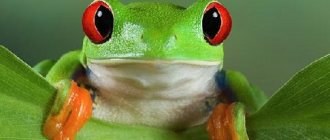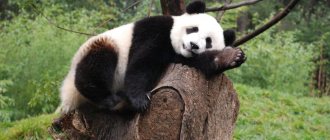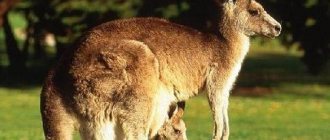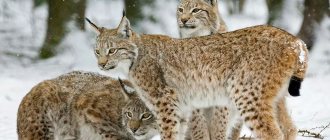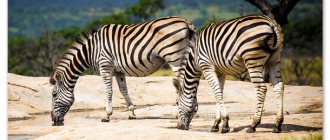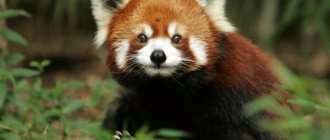- Reports
- Animals
- Panda
The giant panda is a large animal that reaches a length of one and a half to two meters and the weight of this fluffy animal can be from seventeen to one hundred and sixty kilograms. The male panda is ten percent larger than the female panda in length and by as much as twenty percent in weight.
This animal is listed in the Red Book and it also resembles a brown bear; the difference between the animals is the color of their fur. The cute animal is covered with thick and warm fur, the panda's ears, eyes and paws are black, and the body itself is white.
It is considered a predatory animal, but despite this it feeds on mushrooms, flowers, roots, but most of all bamboo leaves. An adult animal can eat up to fifty kilograms of bamboo. If all the bamboo on earth dies, the animal is doomed to starvation.
The giant panda is a very funny and clumsy animal, you just want to cuddle it. People loved the panda very much, and therefore they began to make toys, draw on clothes and make cartoons and interesting films about it, which the younger generation really likes.
The panda lives in areas where its favorite food, BAMBOO, grows in huge quantities. This happens in areas of central and southern China, in forests where it is cool and damp. The soft animal rests during the day in places where direct rays of the sun do not reach, usually in a hollow located in a tree; at night the panda wakes up and is awake. What does a panda do at night? It's very simple, she eats bamboo! It takes a panda about sixteen hours to eat enough. Eating plays a huge role in the life of a giant panda; it is important for her to maintain a large weight.
This animal gives birth to offspring every three to four years. Usually one adult female gives birth to one little panda, in rare cases two little pandas. But unfortunately, only one baby remains alive. Panda offspring are born very small, blind and weak; in the first years of life, babies require close attention. Before giving birth to offspring, a giant panda prepares a den for itself, where it puts branches and various leaves.
There are very interesting facts from the life of giant pandas, for example:
- The panda is popularly called the bamboo bear.
- Scientists have proven that a giant panda is a raccoon, only in large sizes.
- Absolutely all pandas are born white, only after ten days do they develop black spots.
- Adult pandas can grow to be as big as a black bear.
What does it look like?
She looks like a small clumsy bear cub. She has white shaggy fur, and her ears, shoulders, chest and paws are black. Almost cat-like eyes are hidden in the black ovals on her face. Overall, the giant panda is a very charming animal. People fell in love with her so much that he even started making cartoons with her in the title role.
The panda almost always moves on all four legs, swaying from one side to the other. They can run, but cannot withstand a long chase.
Popular message topics
- Desert Animals
Deserts can be found on any continent on earth. Deserts differ from each other in scale, shape, relief, amount of precipitation, air temperature and biological diversity of animal species, but all deserts, without exception, are connected by - Goldfish
Goldfish is a river and lake fish. She was called golden because of her specific body color. Many people do not know that goldfish are an artificially created population of fish. - The Work of Jane Austen
Jane Austen was born in England on December 16, 1775. Since childhood, the girl’s parents instilled in her a love of classical works.
What do they eat?
What is the panda doing at this time? During waking hours she eats. Eating takes a huge place in her life. She needs this in order to maintain body weight. Despite the fact that the panda is classified as a predatory animal, it feeds mainly on bamboo: leaves, buds, and stems. And plant foods are not so nutritious, so we eat at about 16 o'clock at night. Despite the fact that the panda loves bamboo, it can also eat mushrooms, flowers, roots, tubers and grass. And sometimes with fish, if she still manages to catch it from the water.
Report on the topic Panda
The panda or giant panda is a cute, rare mammal listed in the Red Book. It combines the characteristics of a raccoon and a bear. China is considered its homeland. It is interesting that in this country the killing of this animal is one of the most serious crimes and the person who committed it is sentenced to death.
Today many people know what a panda looks like. But it turns out that Europeans became aware of its existence only in the second half of the 19th century, that is, after the missionary A. David acquired a couple of skins of an unknown animal from Chinese hunters. However, for a long time, expeditions that went in search of a hitherto unknown representative of the earth’s fauna ended unsuccessfully. And only in 1936 R. Harkness managed to find and catch two pandas.
Pandas have a massive head with erect ears and a large heavy body, which is covered with thick soft hair of black and white color, and a tail about 12 centimeters long. Their weight can reach 125-160 kilograms. They have sharp claws on their short, thick black paws, which allow them to tenaciously hold bamboo stems, climb trees and defend themselves from offenders. Thanks to their small eyes surrounded by patches of black fur, the animals have a very cute appearance.
Pandas live in bamboo forests, because although they are considered predators, they feed mainly on thin young shoots and leaves of bamboo, which the “sixth finger”, a modified process of the wrist bone, helps to hold. They consume more than ten kilograms of such food per day, which is why they are often called “bamboo bears.” They can also eat insects, bird eggs, saffron and iris bulbs, roots of some plants, etc. They spend 13-16 hours every day searching for food and chew it thoroughly with large wide teeth.
These animals are absolutely unsociable: they prefer to live alone in their territory. They unite in pairs only for reproduction and raising offspring. They usually give birth to 1 or 2 cubs. Moreover, if there are two or three babies, then the female mother feeds and cares for the stronger one. And the weak simply die.
There is a park in China where visitors can see how pandas live.
Panda cubs
Every 2-3 years, one cub is born from each female. It happens that one female gives birth to two or three cubs. But the mother can only go out alone. Before giving birth, she sets up a den in a hollow tree, lining it with leaves and branches. In the first three weeks after birth, the mother panda does not leave her helpless cub, pressing it with her front paws to the nipples.
The cubs are born blind, naked and very tiny.
Each of them weighs only 150 grams. But they grow very quickly. A month after birth, they are already overgrown with fur with black spots, and after another two, their eyes open. Babies begin to walk only at three months. After a year, and sometimes a year and a half, the cub already enters an independent life and leaves the mother’s den. If this message was useful to you, I would be glad to see you in the VKontakte group. Also, thank you if you click on one of the “like” buttons:
Nutrition
The giant panda is related to bears. And, therefore, according to natural laws, it must be a predatory creature. But there are enough exceptions to the rules, especially for unique creatures of nature.
Therefore, the habit of living in certain conditions should also be taken into account. Let's remember: where does the panda live ? These creatures prefer to settle in bamboo thickets, and therefore, taking into account the characteristics of the environment, they have learned and are extremely fond of eating the stems and roots of this plant.
And it is the most basic and favorite dish in their diet. In addition, it is eaten in large quantities, because adult individuals, due to the low productivity of such food as bamboo, are forced to consume it in quantities of up to 15 kg per day.
And such a long habit of eating bamboo, inherent in these animals at the genetic level, simply cannot but affect the biological structure of the body. The giant panda is unable to live without this plant.
Therefore, if the bamboo thickets die, the pandas die too. But the characteristic features of the structure of the predator’s digestion are still preserved. As a result, the stomach of such animals turns out to be not entirely adapted to the thorough processing of this type of food.
Therefore, these animals are forced to regularly supplement their menu with fish, bird eggs and their meat. They also hunt small mammals.
By the way, when dealing with these cute and cute animals in the zoo, you still shouldn’t forget about their predatory nature. Lulled by the charm of these creatures, people stop taking into account the fact that they are quite capable of showing aggression.
As for the red pandas, they are content with approximately the same diet, plus they also eat mushrooms. During the day they eat about 4 kg of bamboo, but always its juicy young shoots.
How long do pandas live?
The lifespan of pandas in natural conditions is about 20 years; those kept in zoos live longer. Basy's panda was recognized as the longest living panda. This panda, while still a baby, became the prototype for the mascot of the first Asian Games in 1990, and died in 2022 after living for 37 years. The farewell ceremony for Basa the panda was broadcast live on Chinese State Television.
Features of the behavior of the red panda
Animals are mainly nocturnal. During the day they sleep in hollows or on tree branches. This is where they hide in case of danger. Pandas are social animals. They live in pairs or small groups. The animals communicate with each other using unusual chirping. In general, red pandas are peace-loving creatures, but if their territory is threatened, they boldly stand up to defend it - hissing and waving their paws.
Red pandas are not picky when it comes to food. They eat bamboo leaves and stems, berries and mushrooms. They will not refuse to eat bird eggs or small rodents. Animals need to eat a lot, since their stomach absorbs a minimal portion of food.
The red panda is one of the funniest wild animals and it is hoped that people will do everything possible to preserve and increase their population.
Description of the red panda
Red pandas are also called small pandas. They don't look much like giant pandas. The animal's body reaches a length of 50-60 cm. The tail can be half the length of a panda and even more - 26-48 cm. An adult male weighs about 4-6 kg. The body of the animal is elongated and elongated. The muzzle is similar to a fox - elongated and sharp. However, the ears are small and round.
The red panda's paws are quite powerful with strong claws. This is due to the fact that the animal spends most of its life in trees. As for the color, it is very bright and beautiful. The coat can be black, dark brown below and red above. Interestingly, the pattern on the face is unique to each animal. In nature, it is impossible to meet two identical red pandas. The tail is usually red with slight variations in shade.
Natural enemies of pandas
Photo of a panda eating
The giant panda is a vulnerable species. Until 2016, it was an endangered species, characterized by a constantly declining population size, as well as a low birth rate, both in the wild and in captivity. The population size of the species in the wild is just over 2,000 individuals. Recently, the number of animals has been gradually increasing, and therefore the status of the species has also changed.
Panda nutritional features
Panda eating bamboo photo
– Advertisement –
Around 13:00 every day, the giant panda searches for food. The diet of this animal consists mainly of young bamboo shoots, and if they cannot be found, the panda is content with old stems. The animal's strong, powerful teeth help it cope with tough bamboo. Since bamboo does not contain many calories, the giant panda chews it almost all the time. During the day, an average-sized adult eats approximately 25-30 kg of bamboo.
For a long time it was believed that bamboo was the only food for giant pandas. But bones were found in the stomachs of dead animals, from which we can conclude that the diet is predatory; sometimes pandas include carrion in their diet. If serious problems arise with the availability of bamboo, animals can switch to feeding on vines, bark, leaves, tree stems, and plant roots.
Mating season
The mating season for red pandas begins in January. The gestation period for a female ranges from 45 to 90 days. And the development of the fetus itself lasts only 50 days and begins a long time after mating. This phenomenon is usually characterized by embryonic diapause. While pregnant, the female begins to prepare a nest from various branches and leaves. It tries to build nests in a quiet place, usually in rock crevices and various tree hollows. A red panda gives birth to one or two cubs. Babies are born completely blind and deaf. They weigh no more than 100 grams.
Red panda cubs
The female fusses with her babies for all 3 months. During this period, little pandas are able to feed on their own and leave the nest. They are separated from their mother only with the birth of a new litter. Due to the delayed maturation period, pandas are forced to live in packs. Pandas between the ages of 2 and 3 years can be considered truly adults.
Interesting facts about the panda:
Logo of the World Wildlife Fund (WWF)
- According to unofficial data, the cost of a giant panda is about $10,000. But paperwork for exporting an animal from China is very complicated, and smuggling will result in a prison sentence of five years or more.
- In China, killing a giant panda is punishable by death.
- The giant panda is the symbol of the World Wildlife Fund (WWF).
- One of the manifestations of cultural exchange between China and the Western world was the rental of giant pandas by zoos in the USA and Japan. The giant panda was first given to Japan as a diplomatic gift by Empress Wu Zetian. Since the late 20th century, the Chinese government has leased giant pandas for 10 years. According to the standard lease terms, the rent is $1,000,000 per year, and includes a guarantee that all cubs born during this time will be the property of China.
- In the early 21st century, the Chinese government offered Taiwan a pair of giant pandas, named Tuan-Tuan and Yuan-Yuan (translated as "reunion"), as a gift to Taiwan. But Taiwan President Chen Shui-bian refused this gift, and the pandas came to the island after the Kuomintang returned to power.
Where does the red panda live?
Where can you meet this wonderful beast? The panda originated in the southeast of the Himalayan mountains at an altitude of almost 4000 meters. The habitat of the red panda is extremely scarce. They can be found in the Yunnan and Sichuan provinces of China, northern Burma and northeastern India. The ancestors of this species could be found in the territories of Eastern Europe and North America. It is believed that changing climatic conditions led to the extinction of this species. Red pandas cannot tolerate dry, hot climates. They settle in areas with temperatures no higher than 25 degrees.
Panda distribution
Areas on the map where pandas live
Giant pandas are found in the mountains of Central China (Sichuan and Tibet). Bamboo forests, dense thickets of which are located in this region, as well as on the islands of Kalimantan and Indonesia, are ideal for the life of this species. Here the animals do not have a shortage of food, and they can easily hide and lead their quiet lifestyle, hidden from prying eyes.
Common panda subspecies
For the giant panda, there are two subspecies:
- Ailuropoda melanoleuca melanoleuca is an inhabitant of Sichuan province, which is characterized by a typical black and white coloration.
Black and white panda photo
- Ailuropoda melanoleuca qinlingensis - found in the Qinling Mountains, Shaanxi Province, at an altitude of 1300 to 3000 m above sea level. It differs from the nominate subspecies in its smaller size, brown and light brown color (instead of black) of the dark areas of the body. This population was discovered in the middle of the last century, but was described as an independent subspecies only at the beginning of the 21st century.
Photo of a brown panda
Reproduction
The mating season for giant pandas lasts from mid-March to May, during which time the animals search for a mate. 4-5 males can claim one female, but as soon as noisy mating has taken place, the animals return to their former solitary lifestyle. After 3-5 months, the female looks for a warm, safe den in a cave or hollow. Having lined the den with leaves and 5 branches, she gives birth to a tiny and helpless cub. Often two or even three cubs are born, but they require such care and attention that the female usually feeds one, dooming the rest to death.
Security
In a relatively short period of time after the discovery of this species, the number of giant pandas has decreased so much that the animal is officially classified as a critically endangered species. Of course, the panda was considered a valuable hunting trophy, but the main reason for its extinction was the deforestation of its natural habitat. As a result, small isolated groups of pandas have remained in small areas, which inevitably leads to inbreeding and weakening of the species gene pool.
In addition, it is known that bamboo plants, depending on the species, die every 40-120 years. In former times, roaming across vast territories, pandas simply moved to where there was more bamboo. Now, their migration routes are often blocked by human settlements or agricultural land.
The danger looming over giant pandas, this symbol of the World Conservation Fund, has aroused interest throughout the world, and since the late 50s the Chinese government has taken serious measures to protect them. Nature reserves have been created in a number of mountainous regions. There is also a state scientific center engaged in programs to increase numbers and study pandas in natural conditions.
According to a forecast once made, by the year 2000 there should not be a single giant panda left in the wild. However, there is hope that, thanks to international efforts, this remarkable animal will be preserved in its native mountain forests.



